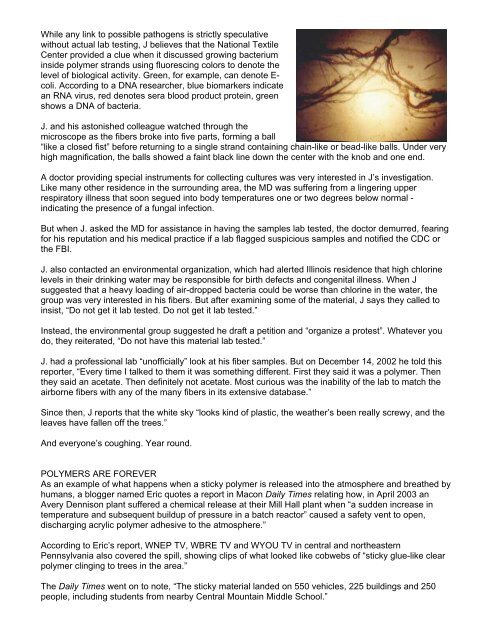CHEMTRAILS%20-%20CONFIRMED%20-%202010%20by%20William%20Thomas
CHEMTRAILS%20-%20CONFIRMED%20-%202010%20by%20William%20Thomas
CHEMTRAILS%20-%20CONFIRMED%20-%202010%20by%20William%20Thomas
You also want an ePaper? Increase the reach of your titles
YUMPU automatically turns print PDFs into web optimized ePapers that Google loves.
While any link to possible pathogens is strictly speculative<br />
without actual lab testing, J believes that the National Textile<br />
Center provided a clue when it discussed growing bacterium<br />
inside polymer strands using fluorescing colors to denote the<br />
level of biological activity. Green, for example, can denote Ecoli.<br />
According to a DNA researcher, blue biomarkers indicate<br />
an RNA virus, red denotes sera blood product protein, green<br />
shows a DNA of bacteria.<br />
J. and his astonished colleague watched through the<br />
microscope as the fibers broke into five parts, forming a ball<br />
“like a closed fist” before returning to a single strand containing chain-like or bead-like balls. Under very<br />
high magnification, the balls showed a faint black line down the center with the knob and one end.<br />
A doctor providing special instruments for collecting cultures was very interested in J’s investigation.<br />
Like many other residence in the surrounding area, the MD was suffering from a lingering upper<br />
respiratory illness that soon segued into body temperatures one or two degrees below normal -<br />
indicating the presence of a fungal infection.<br />
But when J. asked the MD for assistance in having the samples lab tested, the doctor demurred, fearing<br />
for his reputation and his medical practice if a lab flagged suspicious samples and notified the CDC or<br />
the FBI.<br />
J. also contacted an environmental organization, which had alerted Illinois residence that high chlorine<br />
levels in their drinking water may be responsible for birth defects and congenital illness. When J<br />
suggested that a heavy loading of air-dropped bacteria could be worse than chlorine in the water, the<br />
group was very interested in his fibers. But after examining some of the material, J says they called to<br />
insist, “Do not get it lab tested. Do not get it lab tested.”<br />
Instead, the environmental group suggested he draft a petition and “organize a protest”. Whatever you<br />
do, they reiterated, “Do not have this material lab tested.”<br />
J. had a professional lab “unofficially” look at his fiber samples. But on December 14, 2002 he told this<br />
reporter, “Every time I talked to them it was something different. First they said it was a polymer. Then<br />
they said an acetate. Then definitely not acetate. Most curious was the inability of the lab to match the<br />
airborne fibers with any of the many fibers in its extensive database.”<br />
Since then, J reports that the white sky “looks kind of plastic, the weather’s been really screwy, and the<br />
leaves have fallen off the trees.”<br />
And everyone’s coughing. Year round.<br />
POLYMERS ARE FOREVER<br />
As an example of what happens when a sticky polymer is released into the atmosphere and breathed by<br />
humans, a blogger named Eric quotes a report in Macon Daily Times relating how, in April 2003 an<br />
Avery Dennison plant suffered a chemical release at their Mill Hall plant when “a sudden increase in<br />
temperature and subsequent buildup of pressure in a batch reactor” caused a safety vent to open,<br />
discharging acrylic polymer adhesive to the atmosphere.”<br />
According to Eric’s report, WNEP TV, WBRE TV and WYOU TV in central and northeastern<br />
Pennsylvania also covered the spill, showing clips of what looked like cobwebs of “sticky glue-like clear<br />
polymer clinging to trees in the area.”<br />
The Daily Times went on to note, “The sticky material landed on 550 vehicles, 225 buildings and 250<br />
people, including students from nearby Central Mountain Middle School.”


